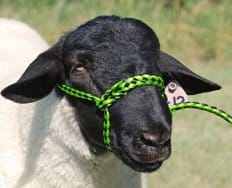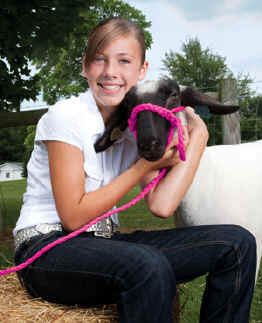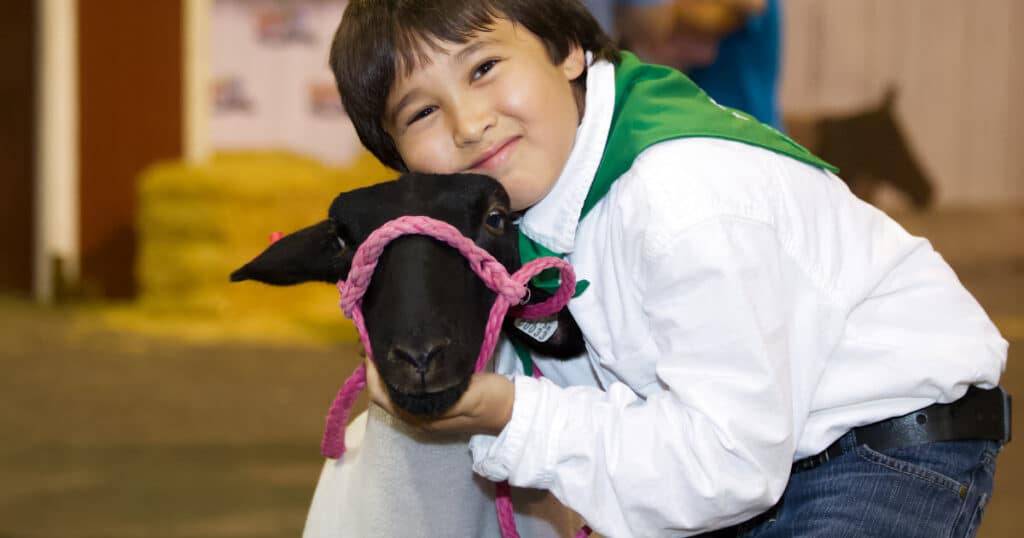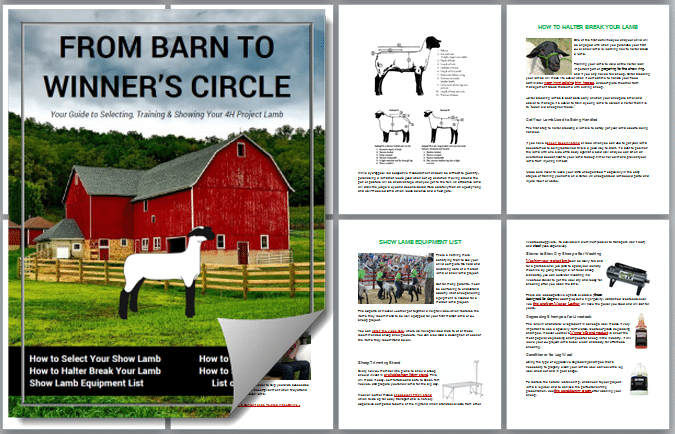One of the first activities you and your child will be engaged with when you purchase your first 4-H or show lamb is learning how to halter break a lamb. Training your lamb to walk on the halter is an important part of preparing for the show ring, and if you only have a few sheep, halter breaking your lambs will make life easier when it comes time to handle your flock, administer worming medicine, trim hooves, etc.
Halter breaking lambs is best done early on when your sheep are easier to manage and it’s easier to train a young lamb to walk on a halter than it is to “teach an old sheep new tricks.”
Get Your FREE 4-H Lamb Guide
From Barn to Winner’s Circle is a 30-page PDF packed with our best tips to take you from buying your first lamb to placing at the top of your showmanship class.
Get Your Lamb Used to Being Handled

The first step to halter breaking a lamb is to safely get your lamb used to being handled. If you have a sheep blocking stand or rack which you can use to get your lamb accustomed to being restrained this is a good way to start.
It’s best to position the lamb with one side of its body against a solid wall and you can sit on an overturned bucket next to your lamb to keep him calm and prevent your lamb from injuring himself.
Make sure never to leave your lamb unsupervised – especially in the early stages of training your lamb on a halter. Start off slow and only restrain your lamb for a few minutes the first day, and reward him or her with some grain afterward.
Introducing Your Lamb to a Halter
Once your lamb has been restrained for a few days you can introduce the halter. It’s best to do this in a familiar way – using the same area and the same routine.
Position the halter on the bridge of your lamb’s nose, under the chin and behind its ears. Make sure that the halter lead comes up under the chin and into your hands on the left side of the lamb. If you stand to the lamb’s left and pull on the halter lead the force should pull the lamb’s head up from under its chin, not down. It’s usually best to tie the lamb against a solid wall (so its legs won’t get injured between panel slats if it fights the restraint) and to gradually increase the duration for which it is tied up with the halter.
I recommend tying your lamb up at first so its first experience walking on a halter comes after it is accustomed to the feeling of wearing its halter.
Choose a cool, shady area and make sure your lambs have access to plenty of water after each training session.
How to Halter Break a Lamb: Final Stage

Once your lamb has been restrained a few times and stands fairly still while tied up on the halter it’s time to begin walking your lamb.
Position yourself just off of the lamb’s left shoulder at first so that he or she is urged to move forward (their natural instinct will be to move away from you).
It’s important not to try to pull or drag your lamb … encourage your sheep to walk forward willingly, and if it balks you can “goose” him gently by pinching just under the sides of its tail, holding the lead loosely in your left hand so the sheep is free to move forward away from you.
If your lamb is still being difficult, remember that sheep have difficulty resisting when moved forward at an angle, so encouraging your lamb to move forward and to the left for a few steps at 45 degrees and then alternate, moving him or her forward to the right at 45 degrees. This technique prevents your lamb from digging in his or her heels and pulling backward. Eventually your lamb will learn to walk willingly on its halter.
The most important thing to remember when learning how to halter break a lamb is to be patient and to encourage your kids to do the same. Remember that this will be a rewarding experience, but that it is a process and your lamb won’t be trained to walk on a halter overnight.
Take your time and set a goal that with a short session each morning or afternoon your lambs will all be walking on a halter by the end of a week. This way your kids can be proud of their hard work and accomplishment when they attend their first show with a docile, halter-broken lamb.
Beginner’s Guide: How to Halter Break a Lamb (Video)
This short video does a pretty nice job of demonstrating some of the techniques I’ve described above:


